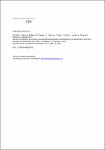Carrier prevalence, secondary household transmission and long-term shedding in two districts during the Escherichia coli O104:H4 outbreak in Germany, 2011
Sin, Muna Abu
Takla, Anja
Flieger, Antje
Prager, Rita
Fruth, Angelika
Tietze, Erhard
Fink, Eckhart
Korte, Jutta
Schink, Susanne
Höhle, Michael
Eckmanns, Tim
Background: From May-July 2011, Germany experienced a large Shiga toxin-producing E. coli (STEC) O104:H4 outbreak. Our objective was to identify the prevalence of STEC O104:H4 carriers in households in highly affected areas, the rate of secondary household transmissions, and the duration of long-term shedding. Methods: In a cross-sectional study, we recruited case and control households to determine STEC household prevalence; we then conducted a prospective cohort study (≥2-persons households with ≥1 case) for rates of household transmission and shedding duration. Results: For part 1, we recruited 57 case households (62 cases and 93 household contacts) and 36 control households (89 household members). We only detected cases in previously known case households and identified 1 possible adult-to-adult household transmission. For part 2, we followed 14 households and 20 carriers. No secondary household transmission was detected in the prospective follow-up. The longest prolonged shedding lasted >7 months, however, median estimated shedding time was 10-14 days (95% CI: 0-33 days). Three carriers showed intermittent shedding. Conclusions: Prevalence of STEC O104:H4 carriers even in highly affected areas appears to be low. Despite prolonged shedding in some patients, secondary adult-to-adult household transmissions seem to be rare events in the post-diarrheal disease phase.
Dateien zu dieser Publikation
Keine Lizenzangabe

